Stock Markets Cleanse House of Speculative Positions
Stock-Markets / Elliott Wave Theory Feb 03, 2008 - 03:57 PM GMTBy: Joseph_Russo

 Free-Market Dynamics vs. Statist Intervention In this particular round (likely the start of the 15 th ), one may assume that at present, the round is even on points. Free Market Dynamics have scored in breaching some minor structural under-pinning's of the artificially-engineered perennial Bull - and the Statists have scored in response - thus far placing a perceived “floor” against the free markets natural propensity to adequately cleanse abuse and excess.
Free-Market Dynamics vs. Statist Intervention In this particular round (likely the start of the 15 th ), one may assume that at present, the round is even on points. Free Market Dynamics have scored in breaching some minor structural under-pinning's of the artificially-engineered perennial Bull - and the Statists have scored in response - thus far placing a perceived “floor” against the free markets natural propensity to adequately cleanse abuse and excess.
House Cleaning
Most are familiar with, and fully grasp the notion that in order for a gaming enterprise to maintain profitability, the “House” must always have a profit advantage. This simple concept is no different for the various market exchanges. The “House” must be profitable and prevail in the facilitation of open exchange. If it fails in this endeavor - the House will inevitably collapse, thus rendering no venue for trade – game-over.
The periodic wild price swings, which are most blatantly observed post FOMC announcements, provide a most opportune time for exchanges to “clean-house” as it were. Participants of either bullish or bearish persuasion are pounded out of their speculative positions, and punished by way of sharp trading losses. As the “house” mops up profit, it concurrently achieves the task of shaking out the largest portion of short-term speculators of every stripe.
Long-Term Analysis / Short-Term Queues
Apart from the inherent propensity and survival-of-the-fittest need for regular house-cleaning, short-term queues not only remain an essential element to the frequent speculator – but in addition, play a useful role in the maintenance and hedging of longer-term positions.
Following this week's short-term trading summary and weekly overview, we will provide a sample of our long-term analysis from across the pond. Elliott Wave Technology's illustration of the German DAX shall provide example of how maintaining a handle on long-range perspectives can assist both traders and investors alike.
Short-Term Trading Environment: Week ending 1-Feb.
Highlighted by Wednesdays FOMC announcement and subsequent series of violent whipsaw reversals, last weeks trade was a futile but necessary exercise in strategic resolve - producing little if any productive short-term benefit.
Re-Capping last week's trading points:
The week began with a classic “throw-under” from a typically bullish falling wedge pattern. Despite the tendency for a false “throw-under” effect, the un-biased mechanical nature of trading the price-action compelled us to sell the breach nonetheless. Profits on such efforts were short-lived, and ultimately stopped for a loss.
Just four 30-minute bars off Mondays weak open; we began hitting a succession of elected long positions, re-situating our short-term trading posture on the right side of the market. All of these long positions went on to achieving their upside price targets.
By Tuesday, equity markets were once again in “levitation-mode,” awaiting announcement of the highly anticipated rate-cut stimulus. Those with experience were likely cognizant of their “sitting-duck” status relative to the impending melee following the public FOMC announcement.
Though appropriate for traders to stand aside amid the mayhem generally associated with FED meetings, we intentionally “trade-through” such noise. In doing so, and despite the added risks, we purposefully maintain a constant mechanical disconnect from all such builds of pent-up emotion and second guessing.
Ignoring discretion, instincts, or individual judgments does not guarantee profits – in fact, nothing does. At times, such instincts will pay off handsomely, and at others – be proven totally wrong. In the end however, monitoring all price-action triggers and trade signals generated by our studies, allows us to record and reflect upon the practical utility and real-world results of steadily applying consistent disciplines throughout all market conditions – win, lose, or draw.
Shortly following Wednesday's public intervention announcement, with high-jinks in full gear, equities spiked sharply higher, and then suddenly collapsed into the close.
Thursday's open was received with some downside follow-through, only to once again – reverse sharply higher - and remain in a generally sustained rising posture throughout the close of trade on Friday.
Amid a highly unstable, artificially supported price-action dynamic, we continue to engage markets with our usual resolve. Last week, such discipline produced a total of 9 short-term trades. Three profitable buy-side trades, five losses on the sell-side, and one aggressive long position that remains open.
Although clients are free to exercise individual discretion and instinct in selecting positions, it is our job to track proprietary strategy mechanically, based exclusively on the price-action, omitting all discretionary selection-bias surrounding pending news, pattern tendencies, or events.
On balance, January was an enormously profitable month; however we concluded its final week of trade virtually flat, with a net capture of just 12-points in the Dow.
Below is graphic summary of this week's rather challenging trade-triggers identified via Elliott Wave Technology's Near Term Outlook .
![]()
![]()
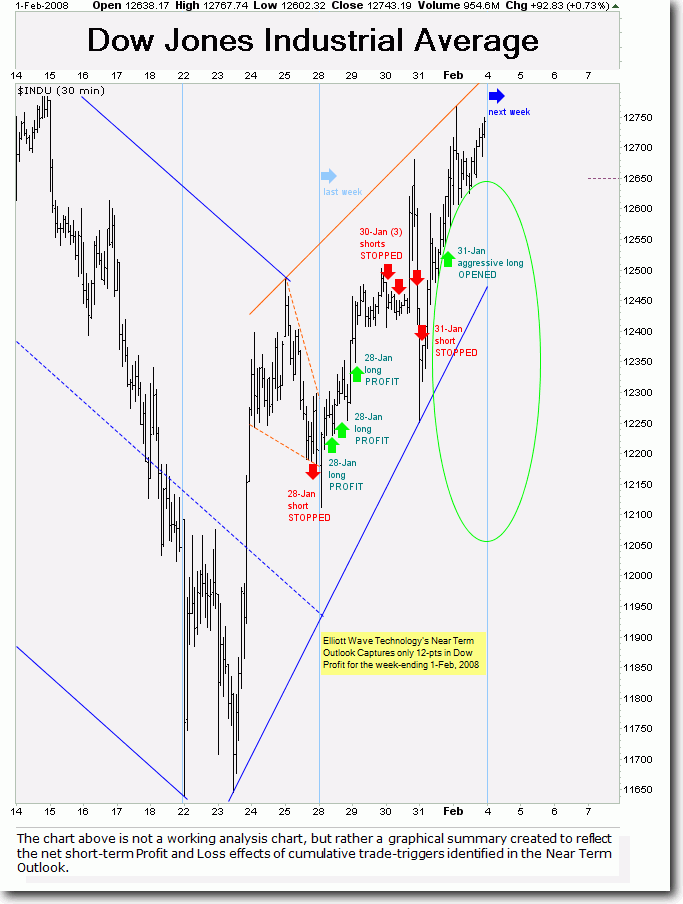
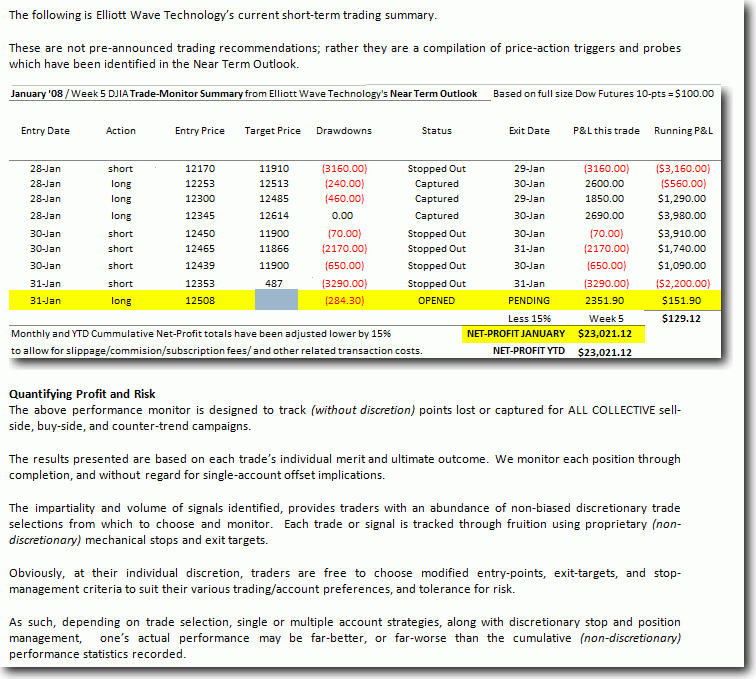
The Broad market update (a weekly perspective)
Our most recent articles have observed broad markets from a long-range monthly perspective. Now that the Statist battle-for-bottom is “on,” we thought it may be useful to observe the effects of such discourse from a closer vantage point.

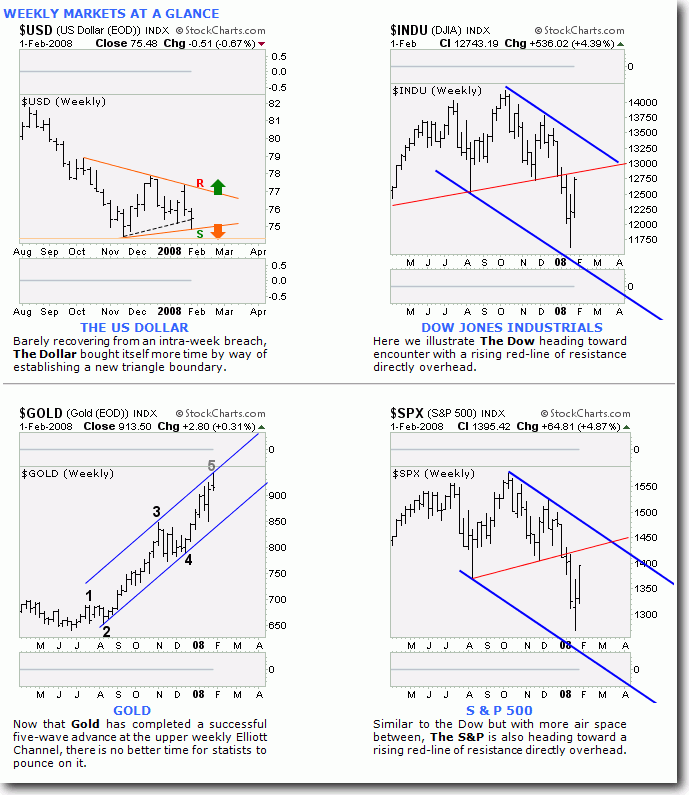
A long-term look across the pond (Germany's Dax)
The chart of the DAX below was taken from our Millennium Wave Quarterly report archives from December 2007.
Aside from a humorous reference made to the charts pattern resembling the logo from the film “V” for Vendetta, it keenly illustrates the complexities and pitfalls common to the ultimate resolution of best applying Elliott Wave labels to larger degree price structures.
One notable example of this is the rise of intermediate wave (b) in 1998, and the pursuant decline to Primary 4 the very same year. At the time, many had assumed the end of the bull market was assured at the (b) wave high – not so, as history shows.
It was not until the maniacal thrust to the 8136.16 high was answered with a 73% percent market wipe-out in 2003 that bulls were forced to raise the white flag and submit. No sooner than the ink could dry on the decree and terms of surrender – another massive bull market campaign was waged.
2008, Five Years Later…
As evidenced via the shaded price series plotting the Euro vs. Gold, which clearly illustrates the level of high-jinks required by the global banking cartels to engineer a rapid and sustained “V” like reflationary B-wave advance at primary degree – we now become witness to the potential of what may ultimately become known as the Great Double-Top.
Of more immediate utility, our observations on December 11, 2007 warned of an imminent 1100-pt decline dead ahead for the DAX. Furthermore, our analysis laid out a strategic downside area in which this pending decline was likely to base.
The 2nd chart that follows will show the immediate outcome of this forward looking analysis.
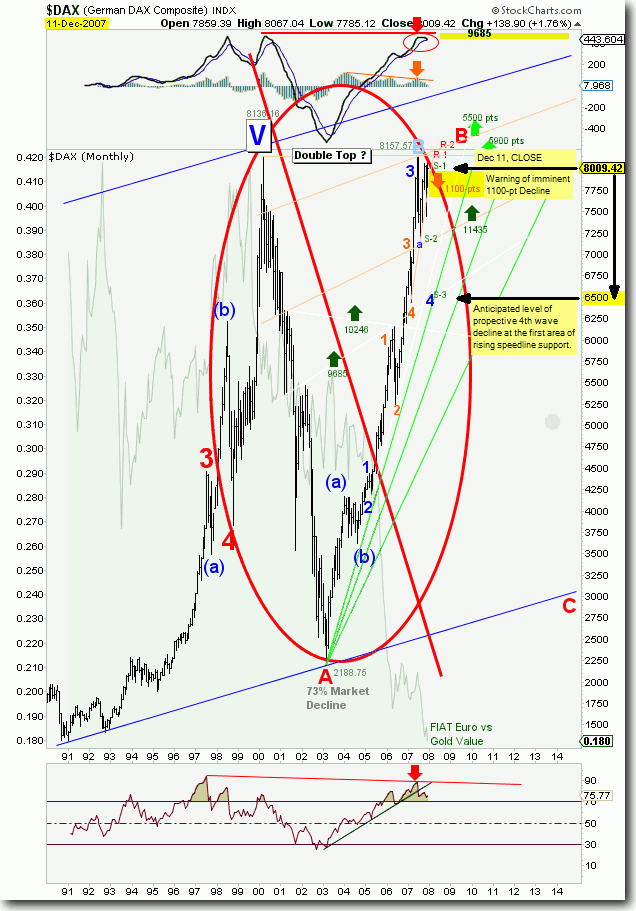
![]()
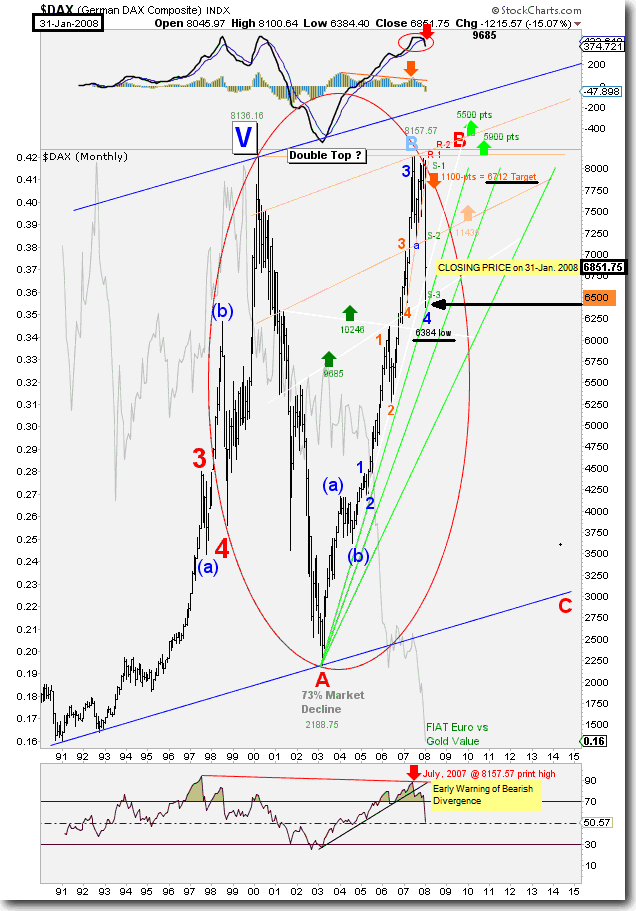
Although we cannot be certain that the DAX will recover to print additional historic highs over the intermediate-term, we do know that it remains plausible given the present set of conditions.
While Elliott Waves eventually work themselves out over the course of time, the same price-action methodology which governs our short-term trading, shall guide us through reconciling the wave counts as they unfold at the highest degrees of trend.
Should one have interest in subscribing to our long-term technical analysis and/or acquiring access to our proprietary short-term market landscapes, we invite you to visit our web-site or blog page for more information.
The Near Term Outlook covers the short-term Dow, S&P, and NDX five-days-per-week, and issues near-term updates for the Dollar, Gold, Crude Oil, and the HUI two times per week.
Trade Better / Invest Smarter...
By Joseph Russo
Chief Editor and Technical Analyst
Elliott Wave Technology
Copyright © 2008 Elliott Wave Technology. All Rights Reserved.
Joseph Russo, presently the Publisher and Chief Market analyst for Elliott Wave Technology, has been studying Elliott Wave Theory, and the Technical Analysis of Financial Markets since 1991 and currently maintains active member status in the "Market Technicians Association." Joe continues to expand his body of knowledge through the MTA's accredited CMT program.
Joseph Russo Archive |
© 2005-2022 http://www.MarketOracle.co.uk - The Market Oracle is a FREE Daily Financial Markets Analysis & Forecasting online publication.


